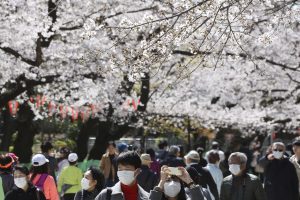By Hayden Marks
As one of the first countries besides China to have been affected by COVID-19, and with the highest percentage of elderly people in the world, who are at higher risk of either becoming seriously ill or dying from the disease, one might assume that Japan would have been at the forefront of developing and implementing measures to help prevent the spread of the disease. Yet, apart from the early closures of schools, which, against expert advice, look set to reopen as early as next week, and a stern warning against congregation and non-essential gatherings, Japan’s measures have seemed almost lax in comparison to the lengths countries such as Italy, the United States, U.K., and Australia have gone to in recent weeks.
In regards to testing for the virus for example, while on the surface Japan may appear to have only a small number of confirmed cases at the present, this low number is most likely the result of its similarly low rate of testing. To highlight just how little Japan is testing, my home state of South Australia, with an estimated population of 1.7 million people, has, at the time of writing, tested 16,717 people. Japan on the other hand, with an estimated population of 126 million people, has only tested 16,484 individuals.
Similarly, while world leaders such as Boris Johnson, Angela Merkel, and Emmanuel Macron have gone on record telling their relative populaces to remain at home and practice social distancing, Japanese Prime Minister Shinzo Abe has been barely sighted throughout the entire ordeal. Yoichi Masuzoe, the former health minister who served during the 2009 swine flu crisis, has even gone so far as to label Abe’s handling of the virus “disastrous.” And nowhere are the results of this lack of leadership more evident than in how the Japanese population has responded.
Over the weekend, despite most of the world being in a state of self-policed lock down, Japanese people flocked in the thousands to cherry blossom hotspots across Tokyo, in celebration of the coming of spring. I visited Shinjuku National Park on Sunday afternoon and witnessed as thousands of revellers — all bottlenecking paths, posing for pictures, having picnics, and intermingling without care — bucked the global trend of social distancing and self-isolation in favor of tradition. Similarly, on Friday night, Shibuya crossing was as busy as ever, restaurants and bars were full of jovial patrons, and the line to the recently opened Shibuya Sky was at least 100 strong, with most viewings booked out entirely. As Harumi Murakami described it for the East Asia Forum: “The contrast between Beijing and Tokyo is striking and unflattering to Japan. Downtown Beijing is deserted as people try to avoid spreading the virus by staying home. Tokyo looks like business as usual, with trains and subways still packed.”
Amid the ongoing crisis, Abe and the Japanese government have yet to develop any real plan to tackle the virus, or provide any real leadership to the people in how they should deal with it. In fact, according to Murakami, Abe has bumbled the country’s response entirely. From failing to place anyone in charge of Japan’ response or create a competent team of experts to deal with the crisis; to failing to incorporate the National Center for Global Health and Medicine, who are heavily involved in infectious disease; to the delay in enlisting the help of the private sector in regards to developing testing kits — every step of the way mismanagement has been rife. Most importantly however, is that while other country’s top leaders have stepped up and provided direction for their people in these pressing times, Abe and his government have been practically invisible. As a result, the people are left not knowing the severity of the virus or just how dangerous simply carrying on business as usual could potentially be.
With studies showing that Japan has yet to hit its peak infection rate, perhaps it’s time for leaders to step up and provide the leadership necessary to prevent what might very well be a catastrophic explosion in cases, in a country where 28 percent of the population rests in the highest risk category for serious illness and death.
Hayden Marks is an English teacher and curriculum developer in Tokyo, Japan. Marks has a Bachelor’s degree in global politics and currently pursuing a Master’s degree in information management.

No comments:
Post a Comment